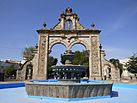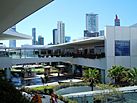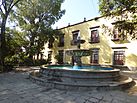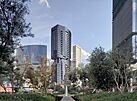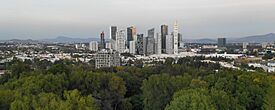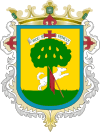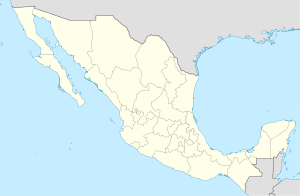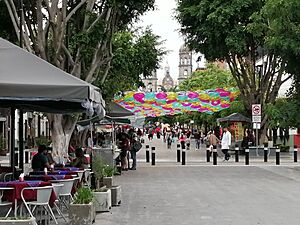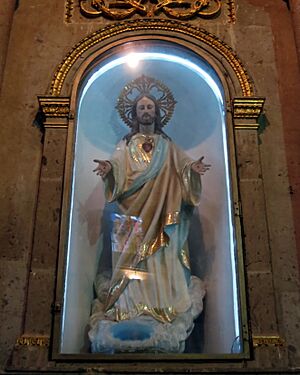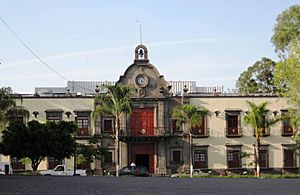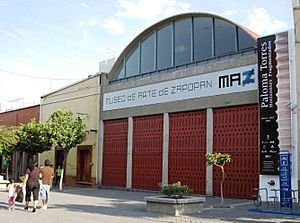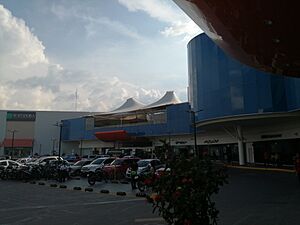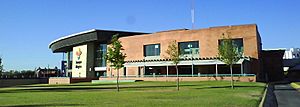Zapopan facts for kids
Quick facts for kids
Zapopan
|
|||
|---|---|---|---|
|
City and municipality
|
|||
|
Clockwise from left: Zapopan Basilica, Monumento del Maíz, Andares Shopping Mall, Puerta de Hierro residences, Municipal Hall, Arcos
|
|||
|
|||
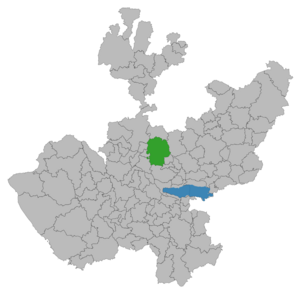
<mapframe frameless align=center width=275 height=250 zoom=11 latitude=20.6660 longitude= -103.3520 />
|
|||
| Country | |||
| State | |||
| Founded | December 8, 1541 | ||
| Founded as | Nuestra Señora de la Concepción de Tzapopan | ||
| Municipal Status | 1825 | ||
| Area | |||
| • Municipality | 893.15 km2 (344.85 sq mi) | ||
| Elevation
(of seat)
|
1,571 m (5,154 ft) | ||
| Population
(2020) Municipality
|
|||
| • Municipality | 1,476,491 | ||
| • Rank | 16th in North America 7th in Mexico |
||
| • Seat | 1,026,492 | ||
| • Seat density | 1,035/km2 (2,680/sq mi) | ||
| Time zone | UTC−6 (CST) | ||
| Postal code (of seat) |
45010
|
||
| Area code(s) | 33 | ||
| Demonym | Zapopano | ||
| Website | Municipal official site: http://www.zapopan.gob.mx/ | ||
Zapopan (Spanish pronunciation: [saˈpopan]) is a big city and municipality in the Mexican state of Jalisco. It's part of the Guadalajara Metropolitan Area. Zapopan is the largest city in Jalisco, after Guadalajara itself. It's famous for being home to the Virgin of Zapopan, a special statue of the Virgin Mary from the 1500s. People believe this statue has performed many miracles. Even Pope John Paul II visited it!
The name Zapopan means "among the sapote trees" in the Nahuatl language. It used to be called "ex Villa Maicera" or "former Corn Village" because it grew a lot of corn. The city's official seal was created in 1941 for its 400th birthday.
Contents
History of Zapopan
Early Beginnings
From 1160 to 1325, many families like the Zapotec, Nahua, and Maya moved here. They settled near the Profundo Arroyo. These groups mixed with others, including the Aztecs, and became known as Tecos. They built small shrines to worship the sun and a corn god called Teopiltzintli.
When the Spanish arrived, Tzapopan was a large town. But it was getting smaller because of wars with other tribes. It was under the rule of Atemajac, which was part of the bigger kingdom of Tonalá.
Spanish Arrival and Founding
In 1530, Nuño de Guzmán took control of this area. However, the Spanish didn't truly settle Zapopan until 1541, after the Mixtón War. That year, Francisco de Bobadilla brought 130 native people from his lands to live in Zapopan. With them came a statue of Our Lady of the Conception. This statue later became known as Our Lady of Zapopan. The church for this statue started being built in 1689.
Becoming a City
In 1824, Zapopan became the center of one of the 26 areas of the new state of Jalisco. It kept this important role even after changes in 1837. In 1873, General Ramon Corona fought a battle here against rebels.
A very special event happened in 1979: Pope John Paul II visited the Basilica of Our Lady of Zapopan. In 1991, Zapopan officially became a city. This was celebrated on December 8, which was 450 years after the city's founding.
Zapopan is now the second largest municipality in Jalisco. It is the seventh largest municipality in all of Mexico.
Things to See and Do in Zapopan
Zapopan has many interesting places to visit. You can find important religious sites and modern shopping malls. There are also places for outdoor activities like El Diente and Bosque de La Primavera. The city has great hotels, large show venues, and museums with amazing exhibitions.
Basilica of Zapopan and the Virgin
The Virgin of Zapopan is a statue of Our Lady of the Conception. It was made in the early 1500s by native artists in Michoacán. The statue is 34 centimeters (about 13 inches) tall. It is made from corn stalks, except for its wooden hands. This statue was given to help spread Christianity. Legend says it helped end the Mixtón War and stopped diseases in the 1600s.
The statue was even named the "General" (La Generela) of the Army of the Three Guarantees in 1821. This military title was confirmed again later. In 1919, Pope Benedict XV crowned it the Queen of Jalisco.
Building the Basilica of Zapopan started in 1689 and finished in 1892. It has been changed and made bigger since then. In front of the church is a large open area called an atrium. Here you can see bronze statues of Antonio de Segovia, who gave the Virgin statue, and Pope John Paul II.
The main altar inside is made of marble. The Virgin of Zapopan statue is at the top in a glass case. Another important sculpture is the Holy Family, which has been in the church since 1832. In 1940, Pope Pius XII made the church a basilica.
Part of the basilica building is home to the Huichol Museum. This museum shows the art and culture of the Huichol people. It also has displays from the Tepehuán and Cora peoples. Another part of the basilica has the Museum of the Virgin of Zapopan. Here you can see gifts left for the statue and items used for its worship.
Every year on October 12, there's a huge parade for the Virgin. This tradition began in 1734. The statue is carried from the Guadalajara Cathedral to the Basilica of Zapopan. The streets are filled with dancers, food sellers, and spectators. The statue stops for traditional dance groups and mariachi bands. After it returns to the Basilica, celebrations continue with fireworks.
Other Important Places
The Arco de Ingreso a Zapopan (Entrance Arch) is on Paseo Teopiltzintli. It was built by the Spanish founders. This stone arch is 20 meters (about 65 feet) high. It has sculptures and is topped with large jars and an eagle.
The Plaza de las Américas—Juan Pablo II Square is next to the Basilica. It has pink stone, a kiosk, and four fountains. There are also two large bronze statues of the corn god and goddess. A statue of John Paul II is here too.
Andador 20 de Noviembre is a main walking street. It has galleries, bars, and restaurants. On Saturdays, artists and antique dealers sell their items here.
The Municipal Palace was built in 1942 as a school. It became the city government's home in 1968. The building's staircase has a mural called “La Revolución Universal.” It shows scenes from different revolutions and indigenous art. The Civic Plaza in front has a tall flagpole and a bronze eagle sculpture.
The Municipal Cultural Center, built in 1979, hosts art shows, plays, and dance events. Next to it is the Plaza del Arte, with arches, columns, and sculptures. The main mural inside is “La Historia de la Villa y la Revolución Mexicana.”
The Estadio Akron is a football stadium for the C.D. Guadalajara team. It's near the Bosque de la Primavera. The stadium covers 147,000 square meters (about 1.5 million square feet) and seats over 45,000 people.
The Temple of San Pedro Apóstol is a beautiful church finished in the late 1800s. Inside, there's a sculpture of Saint Peter by J. Cruz de la Mora. The church also has a 17th-century painting called “The Baptism of Jesus.”
The Centro Cultural Universitario is a huge cultural project. It includes the Auditorio Telmex, a major concert hall in Latin America. There's also the Foro Alterno for 15,000 people. This project also has the Juan José Arreola State Library and the Environmental Science Museum.
Other cultural spots include:
- Galerías Theater: For musicals, concerts, and festivals.
- Museo de Arte de Zapopan (Zapopan Art Museum): Shows art exhibitions and workshops.
- Museo de Cacería Albarrán (Albarrán Hunting Museum): Displays 270 hunting trophies from around the world.
Shopping Centers
Zapopan has many shopping malls, including:
- Andares
- Distrito La Perla
- University Square
- Patio La Cima
- Plaza Cordilleras
- Plaza San Isidro
- Bugambilias Square
- Plaza Las Fuentes
- Plaza Santa Margarita
- Tepeyac Square
- Plaza Las Aguilas
- Guadalupe Square
- South Square
- Plaza Aqueduct
- Belenes terrace square
- Gallery Square
- Plaza Real Center
Zapopum Festival
The Zapopum Festival started in 2005 as a local fair. It has grown into a big cultural event. It brings culture to people who enjoy different kinds of shows. The festival features acrobats and circus acts from around the world. There are also workshops, themed areas, and shows by famous Mexican artists. This event has attracted up to 800,000 people in past years.
Zapopan Municipality
The city of Zapopan is the main government center for about 750 other smaller communities. These communities make up the municipality, which covers 893.15 square kilometers (about 345 square miles). Most of the people in the municipality live in the city itself. Zapopan is the second most populated municipality in Jalisco and the seventh in Mexico.
Geography and Climate
Most of the municipality is flat, with some rolling hills. The land is between 1,500 and 2,000 meters (about 4,900 to 6,500 feet) above sea level. The highest points are in the Sierra de la Primavera mountains. Water flows into streams that lead to the Grande or Santiago River. There are three dams: Copalita, Santa Lucia, and San Jose.
Winters are mild, especially in lower areas. The average temperature all year is 22°C (72°F). Highs can reach 36°C (97°F) and lows can be 11°C (52°F). Most of the rain falls from June to October.
| Climate data for Zapopan (1951–2010) | |||||||||||||
|---|---|---|---|---|---|---|---|---|---|---|---|---|---|
| Month | Jan | Feb | Mar | Apr | May | Jun | Jul | Aug | Sep | Oct | Nov | Dec | Year |
| Record high °C (°F) | 36.0 (96.8) |
39.0 (102.2) |
40.5 (104.9) |
42.0 (107.6) |
41.0 (105.8) |
41.0 (105.8) |
36.5 (97.7) |
38.5 (101.3) |
37.0 (98.6) |
39.0 (102.2) |
39.0 (102.2) |
39.0 (102.2) |
42.0 (107.6) |
| Mean daily maximum °C (°F) | 25.1 (77.2) |
27.3 (81.1) |
29.9 (85.8) |
32.3 (90.1) |
33.5 (92.3) |
31.1 (88.0) |
27.8 (82.0) |
27.8 (82.0) |
27.6 (81.7) |
27.5 (81.5) |
26.6 (79.9) |
25.0 (77.0) |
28.5 (83.3) |
| Daily mean °C (°F) | 16.8 (62.2) |
18.4 (65.1) |
20.4 (68.7) |
22.6 (72.7) |
24.2 (75.6) |
23.6 (74.5) |
21.8 (71.2) |
21.8 (71.2) |
21.7 (71.1) |
20.7 (69.3) |
18.7 (65.7) |
17.0 (62.6) |
20.6 (69.1) |
| Mean daily minimum °C (°F) | 8.4 (47.1) |
9.5 (49.1) |
10.8 (51.4) |
13.0 (55.4) |
15.0 (59.0) |
16.1 (61.0) |
15.8 (60.4) |
15.7 (60.3) |
15.7 (60.3) |
14.0 (57.2) |
10.8 (51.4) |
9.0 (48.2) |
12.8 (55.0) |
| Record low °C (°F) | −4.0 (24.8) |
−2.0 (28.4) |
1.0 (33.8) |
1.0 (33.8) |
7.0 (44.6) |
7.0 (44.6) |
7.0 (44.6) |
6.0 (42.8) |
8.0 (46.4) |
7.0 (44.6) |
1.0 (33.8) |
−7.0 (19.4) |
−7.0 (19.4) |
| Average precipitation mm (inches) | 15.1 (0.59) |
10.0 (0.39) |
4.5 (0.18) |
4.2 (0.17) |
23.0 (0.91) |
195.5 (7.70) |
264.1 (10.40) |
217.8 (8.57) |
163.8 (6.45) |
60.4 (2.38) |
13.5 (0.53) |
12.1 (0.48) |
984.0 (38.74) |
| Average precipitation days (≥ 0.1 mm) | 2.1 | 1.1 | 0.5 | 1.0 | 3.1 | 14.2 | 20.0 | 18.7 | 14.1 | 6.2 | 1.6 | 2.1 | 84.7 |
| Source: Servicio Meteorológico Nacional | |||||||||||||
Plants and Animals
The Sierra de la Primavera has pine and holm oak trees. Lower areas have plants like jonote and nopals. While much wildlife has disappeared, the Bosque el Nixticuil is a protected area. It is home to many mammals, reptiles, amphibians, birds, and insects.
Economy and Jobs
About three-quarters of the municipality's land is used for farming and raising animals. About 15% is forest, and the rest is the city of Zapopan. Farmers grow corn, sorghum, squash, tomatoes, chickpeas, avocados, mangos, and plums. They also raise cattle, pigs, and chickens. Farming employs less than 3% of the people.
About one-third of the people work in factories and manufacturing. Big companies like Kodak, Motorola, and Coca-Cola have facilities here. The rest of the people work in stores and services.
Zapopan is known for its shopping malls, private hospitals, and nice neighborhoods. It is one of the wealthiest municipalities in Mexico.
Nature and Archeology
Zapopan offers many natural attractions. You can visit the Ixcatán Geysers and the La Cola de Caballo waterfall. At the Santa Lucia dam, you can fish and go boating. The Cola de Caballo is a 150-meter (about 490-foot) tall waterfall. The Ixcatan Geysers are hot springs that shoot water up to 5 meters (about 16 feet) high at 45°C (113°F).
At Cerro del Diente, there are large rocks for mountain climbing and rappelling. The Barranca del Río Santiago is a huge canyon, 3.5 kilometers (2.2 miles) wide and 700 meters (2,300 feet) deep. The Bosque de la Primavera (Primavera Forest) covers 30,500 hectares (75,000 acres). It has fresh and thermal springs, plus diverse plants and animals. There are hiking trails with signs.
The Bosque El Centinela is another forest area. It was replanted in the 1970s and has mountain biking paths and campgrounds. There are also water parks like Rio Caliente and La Primavera.
The municipality has three main ancient sites. Ixtépete has a pyramid built between the 5th and 10th centuries. It is 20 meters (65 feet) long, 16 meters (52 feet) wide, and 1.83 meters (6 feet) high. El Grillo has fourteen tombs along a dry stream. La Coronilla is in an area called La Experiencia. Ancient tombs and objects have been found in and around Zapopan, like pots and figures from 100 BCE to 500 CE.
The La Mojonera Ranch was the site of a battle in 1873. Government forces fought rebels led by Manuel Lozada.
Population Growth
In 1950, Zapopan had 27,115 people. By 1960, the population doubled to 54,562. It grew even faster in the 1960s, reaching 163,185 by 1970. By 1980, it was 389,081. In 1990, Zapopan had 712,008 people, and by 2000, it had over one million residents.
Local Government
Zapopan is led by a municipal president, who is like a mayor. This person holds power for three years. The municipal president works with a group called the [cabildo], which helps make laws.
The city government provides public services. These include drinking water, drainage, street lighting, public safety, and traffic rules. They also take care of parks, gardens, and cemeteries. They help with public education, rescue services, and protecting the environment. The city hall collects taxes and can get money from the state and federal governments.
Education in Zapopan
Zapopan has many excellent universities and schools.
Universities
- Universidad Panamericana, Guadalajara campus
- Universidad Autonoma de Guadalajara
- Instituto Tecnológico y de Estudios Superiores de Monterrey (ITESM) - its second largest campus
Schools
- Colegio Alemán de Guadalajara, a German international school
- Lycée Français de Guadalajara, a French international school
- Instituto de Ciencias, a Jesuit Catholic private school
- Instituto Miguel Ángel de Occidente
- Colegio Cervantes, a private Catholic school run by Marist Brothers
There is also a part-time Japanese school, the Colegio Japones de Guadalajara A.C. (Guadarahara Hoshū Jugyō Kō). It offers lessons in the afternoon.
Coat of Arms
The Coat of Arms of Zapopan is the official symbol of the municipality. It is used by the local government on all its documents. The shield is important because it shows a sapote tree, which is where the town got its name.
The shield has a green background and a gold field. It shows a green tree with seven gold sapote fruits. Next to the tree is a spear with a red flag. Behind the tree, a silver dog is jumping. There is also a red cross and a silver badge that says "HOC SIGNUM VINCIT," which means "This Sign Shall Win."
Culture
Zapopan is part of the larger city of Guadalajara. This means it has a rich cultural scene. There are many events and cultural activities. These are supported by public and private groups, especially the government and the University of Guadalajara.
Museums and Galleries
Zapopan has many museums:
- Zapopan Art Museum (MAZ): Shows different kinds of art and exhibitions. It has three halls and a forum for music, dance, theater, and videos.
- Trompo Mágico: An interactive museum for children. It teaches about art, science, and civics through fun activities.
- Garden of Art: An outdoor art show and sale every Sunday at Glorieta Chapalita.
- Mexican Air Force Air College: Has a history gallery of the Mexican Air Force and aircraft models.
- Benito Albarrán Hunting Museum: Displays 270 hunting trophies from different continents.
- Huichol Wixárica Museum of Art: Shows handicrafts from the Huichol people. You can see shirts, bags, necklaces, and masks.
- Museum of the Virgin of Zapopan: Has a collection of silver and gold mantles given to the Virgin. It also shows old paintings and items used for worship.
Art and Food
Zapopan has important paintings. "The Baptism of Jesus" from the 17th century by Juan Correa is one. The Municipal Center of Culture has a mural called "The History of the Villa and the Mexican Revolution" by Ricardo Peña. The municipal palace has a mural by Guillermo Chavez Vega showing scenes from different revolutions.
Like the rest of Mexico, Zapopan has many foods made from corn. These include pozole, tamales, and atole. Other popular dishes are torta ahogada and esquites (cooked corn kernels with toppings). Traditional sweets include those made with coconut and milk.
Ancient Sites
Zapopan has three important ancient sites:
- Ixtépete: A pyramid with influence from Teotihuacan. It was built between the 5th and 10th centuries.
- El Grillo: Located north of the Atemajac Valley. It has fourteen tombs along a dry stream.
- La Coronilla: Found in an area called La Experiencia.
Sports in Zapopan
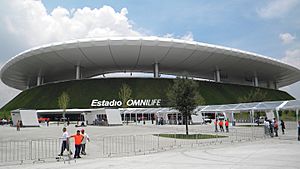
Zapopan has many sports thanks to its great facilities. The Municipal Sports Council (COMUDE) promotes physical activity and sports. The municipality has about 54 sports centers for practicing sports and learning new ones.
Zapopan has hosted many national and international sports events. In October 2011, it was a host city for some competitions of the Pan American Games.
The city is home to the Third of March Stadium, where the Tecos team plays. The Chivas de Guadalajara team has the Estadio Chivas (now Estadio Akron). This stadium opened in July 2010. It has hosted important events like the Pan American Football final and the Copa Libertadores final. It also holds concerts.
Via RecreActiva
The Vía RecreActiva is a special program in Zapopan. On Sundays, certain roads are closed to cars from 8:00 a.m. to 2:00 p.m. This allows people of all ages to walk, bike, or skate safely.
There are three routes in Zapopan:
- ROUTE 1: South Extension (6.4 km) along Avenida de las Rosas, Tepeyac, and other streets.
- ROUTE 2: South Extension (10 km) along Labna, Amado Nervo, and other streets.
- ROUTE 3: North Extension (8 km) along Avenida Hidalgo, May 5, and other streets.
Sister Cities
Zapopan is connected with other cities around the world:
 Antigua Guatemala, Guatemala
Antigua Guatemala, Guatemala Cartago, Costa Rica
Cartago, Costa Rica Changwon, South Korea
Changwon, South Korea Chengdu, China
Chengdu, China Częstochowa, Poland
Częstochowa, Poland Grand Rapids, Michigan, United States
Grand Rapids, Michigan, United States Jinan, China
Jinan, China Marianao (Havana), Cuba
Marianao (Havana), Cuba Rosemead, California, United States
Rosemead, California, United States Saginaw, Michigan, United States
Saginaw, Michigan, United States San Pedro Sula, Honduras
San Pedro Sula, Honduras Adelaide, Australia
Adelaide, Australia Kiryat Bialik, Israel
Kiryat Bialik, Israel
Zapopan also has partnerships within Mexico:
And international cooperation agreements:
 Amsterdam, the Netherlands
Amsterdam, the Netherlands Phoenix, Arizona, United States
Phoenix, Arizona, United States Medellin, Colombia
Medellin, Colombia Zaragoza, Spain
Zaragoza, Spain Stuttgart, Germany
Stuttgart, Germany Angoulême, France
Angoulême, France
See also
 In Spanish: Zapopan para niños
In Spanish: Zapopan para niños




